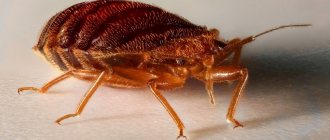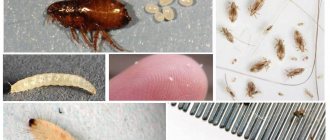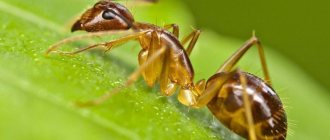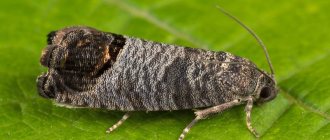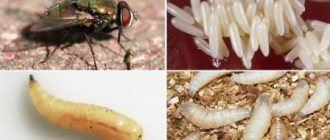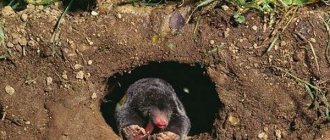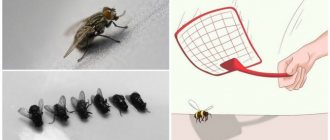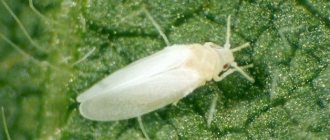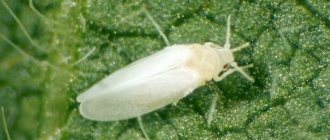30.06.2019
It is impossible to insure against the appearance of harmful insects on carefully grown seedlings. Omnivorous insects attack young shoots, inflorescences, and can destroy the entire crop. What pests can be encountered in a greenhouse when planting peppers and tomatoes, the life cycle of these parasites, as well as a review of effective means of combating them is given below.
- What caterpillars breed in a greenhouse?
- Pest development stages
- Effective treatment methods and control methods
- How to prepare a greenhouse for planting
Why do I get rid of caterpillars in the greenhouse?
I always try to prevent pests from appearing in my area. If uninvited guests show up, without wasting time, I begin processing the plants. Being late threatens the destruction of plantings and serious damage to the harvest.
Caterpillars, one of the most voracious pests, are especially dangerous here. If measures are not taken in time, they will deprive the harvest. Such pests can be found not only in open garden beds, but also in greenhouses. In the comfortable conditions of a greenhouse, they are active and voracious. They practically do not have to fear natural enemies - birds, predatory insects.
Having discovered caterpillars in the greenhouse, I turn to proven folk methods. If the method is not effective, turn to specialized chemicals. And I don’t forget about preventing the appearance of these gluttonous enemies.
Chemicals for processing tomatoes
The most effective method of controlling caterpillars on tomatoes in a greenhouse is to treat the plants with chemicals. These substances are removed from the fruit over the course of a month.
Chemicals to help control insects
To fight the caterpillar with pesticides, you should follow the instructions for this substance, since excessive amounts of them in tomatoes can cause serious poisoning. Let's consider the most effective means:
- "Inta-Vir" is a drug that helps fight pests at any stage of its development.
- "Decis" protects tomatoes in a greenhouse for a couple of weeks and acts very quickly.
- “Avant” is a product that is resistant to rain and even affects parasite eggs.
Other effective poisons that help fight caterpillars on tomatoes include Aktara, Iskra, Mospilan, and Admiral. Over time, the caterpillar located on tomatoes treated with these pesticides develops immunity. After this, the drug should be changed.
Tatyana Orlova (candidate of agricultural sciences):
In order not to miss the appearance of insect pest butterflies, and also to catch them, you can use glue traps. All insects are attracted to the color yellow. Gardening stores now sell these yellow glue traps. You can make them yourself.
A sheet of yellow paper is glued onto the cardboard and coated with non-drying glue. Several of these traps are hung in the greenhouse. The appearance of butterflies stuck to the traps signals that it is necessary to spray the tomatoes in the greenhouse with insecticides.
What caterpillars appear in the greenhouse and what do they eat?
Gardeners need to be wary of two types of caterpillars: whiteflies and armyworms. I’ll tell you how to recognize them and how exactly these uninvited guests harm you.
Cutworm caterpillars
Adult representatives are inconspicuous butterflies that resemble moths. Quite small - 3-4 cm. Their body is gray-brown, and on the wings there is a pattern of strokes and stripes.
scoop butterfly
Cutworms are very prolific - an adult leaves up to 500 eggs over the summer. The masonry is made on the leaves and flowers of greenhouse plants. Armyworm eggs are convex on top and flat on the bottom. In warm conditions they ripen in 2-5 days, in cool conditions - in 4-10.
The caterpillar itself takes longer to develop – up to 20 days. Its body is naked, grayish, yellow-green, brownish dim in color. The pests are large and long – up to 2 cm. It is quite difficult to detect them – both caterpillars and cutworm butterflies are active at night. At the end of the development stage, the caterpillars move into the soil, where they pupate and survive the winter. Adult cutworms live 20-40 days.
The caterpillars do the greatest harm to greenhouse tomatoes - they start their “lunch” with tops and buds, and then move on to tomatoes. They gnaw holes in the fruits, where they live and feed, “without leaving the cash register.” Tomatoes affected by caterpillars are not suitable for consumption. In addition to tomatoes, pests are not averse to eating eggplants, cabbage, and peppers.
Whiteflies
Adult whiteflies are very small (2-3 mm) butterflies that can easily be confused with midges. I recognize them by their white, yellowish body, wings with white “powder”. I detect whiteflies by moving and shaking the seedling - the butterflies immediately take off in a friendly swarm.
Both caterpillars and adults live on the lower part of the leaves, sucking cell juices from them. The larvae themselves are practically invisible to the human eye - small, translucent. In the first days of life they are mobile. Then they attach to the feeding site and practically do not move.
Warm and humid greenhouse climates are the most favorable for whiteflies. When the temperature drops to 10 C they die. But the eggs laid by whiteflies calmly survive the winter cold in the upper layers of the soil.
whitefly on vegetables
The danger of whitefly caterpillars is not only in drawing out cell sap. These pests are carriers of infections. Plants are inhibited in growth, do not form new ovaries, and produce deformed fruits unsuitable for nutrition. Whitefly affects most greenhouse crops - tomatoes, peppers, eggplants.
Chemicals
How to deal with green caterpillars on tomatoes in a greenhouse? Chemical treatment is the most effective method of pest control. Spraying is carried out taking into account the fact that pesticides are removed from the fruit within 20-30 days. Therefore, before using chemicals, calculate the expected start date of harvest.
Attention! Gloves are used to protect the skin, and respirators are used to protect the respiratory system.
List of effective means:
- "Inta-Vir" is a contact-intestinal insecticide. The substance cypermethrin destroys butterflies and caterpillars. The protective effect lasts up to 15 days. Dissolve 1 tablet in 10 liters of water and use it during the tomato growing season.
- "Decis Profi" is a fast-acting contact-intestinal insecticide. Belongs to the class of pesticides moderately hazardous to humans. Contains the substance deltamethrin. To treat 100 m², 0.5 g of the substance is dissolved in 5 liters of water. The product is used before flowering. The protection period is 10-15 days.
- "Avant" is an insecticide of moderate hazard class for humans. Contains the substance indoxacarb. Resistant to rain, effectively destroys eggs and caterpillars. The consumption rate per 1 ha is 200-300 ml. The product is used no more than twice during the growing season.
- "Arrivo" is a contact-intestinal insecticide. Shows high effectiveness against cutworm caterpillars at low application rates. Consumption per 1 ha – 240-320 ml. Treatment is one-time, during the growing season.
- "Aktara" is a systemic insecticide with contact-intestinal action. The active ingredient is thiamethoxam. Destroys the caterpillar at the feeding stage. 4 g of powder for irrigation or 1.2 g for spraying are dissolved in 10 liters of water.
- "Tanrek" is a systemic insecticide with contact-intestinal action. The active ingredient is imidacloprid. The protection period is 30 days. The drug can be combined with Fitosporin. The product is used for spraying (5 ml per 10 liters of water).
- "Fitoverm" is an enteric contact insectoacaricide. Irrigation is carried out twice during the entire growing season. 1 ml of the drug is dissolved in 10 liters of water. The protection period in the greenhouse is up to 20 days, in the garden – up to 15 days.
Important! It is recommended to alternate chemicals used to kill cutworm caterpillars from season to season. The pest is highly resistant to such agents. What worked this year will not work next year.
Signs of caterpillars appearing in a greenhouse
I recognize its appearance by characteristic signs:
- Small and adult pests appear on the lower part of the leaves.
- The upper part of the leaf is covered with white “powder” and then turns black.
- Tops affected by caterpillars dry out and curl.
- Affected tomatoes have inedible, whitish pulp.
- The tops have characteristic features: “bite” marks, uneven edges, empty spots.
- There are gnawed passages on the tomatoes, and the pests themselves are in the pulp.
Cutworm caterpillars are clearly visible to the naked eye. Adult whiteflies can be easily detected by shaking the plants - the butterflies will swirl in the air.
Why do caterpillars appear in a greenhouse?
Caterpillars enter the greenhouse in two main ways:
- An adult flew into a greenhouse and laid eggs. Caterpillars have already developed from them.
- The soil in the greenhouse is contaminated - pupae and larvae remain from last season. With the onset of warmth, they become active, quickly develop and reproduce.
Cutworms and whiteflies are attracted by the comfortable greenhouse microclimate - warmth, humidity. Therefore, I do not forget to ventilate the greenhouse to get rid of condensation and ensure normal air circulation.
Pests also love overly thickened plantings - they lay eggs there. Therefore, timely weeding, thinning, and formation of cultivated plants are so important. Do not forget to cut off stepsons, old lower branches, and unnecessary side shoots.
Scoops: description
Noctules are sometimes called noctules. The first cutworms were described at the beginning of the 19th century, and now about 35,000 species of these insects are known, but not all of them are garden pests.
The wingspan of the moth usually reaches 45 mm, although there are much larger specimens in the family. The scoop is painted in a discreet grayish color. She spends the winter in the pupal phase in the upper layer of soil, and in the spring she flies out and lays eggs on the leaves of garden plants already on the 4-5th day. After about seven days, the eggs hatch into caterpillars, and after three weeks they become adults. During these three weeks, the caterpillars cause serious damage to the tomato beds. They devour leaves, stems and fruits of tomatoes, causing the bushes to wither and die. But during the summer, cutworms produce more than one generation of caterpillars.
Methods for getting rid of caterpillars in a greenhouse
I will present to you effective ways to resist caterpillars, which I have already tried from my own experience.
Chemicals
The most effective counteraction to caterpillars is the use of pesticides. But I will warn you that these products are also dangerous for people: pesticides are completely removed from the plantings and their fruits in at least 20-30 days. Therefore, I always calculate the expected harvest time before processing. If this period is short, I still prefer to use other drugs.
Treating greenhouse plants with insecticides is a last resort. Toxic substances enter the greenhouse substrate, accumulate there, and are absorbed by more than one generation of plantings. The drugs of the 4th hazard class are the fastest to be removed from plants - “Aktofit”, “Lepidotsid”, “Fitoverm”, “Agravertin”.
I always carry out processing in closed conditions with all precautions - I cannot do without a respirator, protective clothing, thick gloves and goggles. I open the windows and doors and try to spray the plants as quickly as possible.
For treatment, I choose universal preparations that destroy both caterpillars and adult whiteflies, cutworms:
- "Intavir". The active ingredients affect caterpillars at all stages of development and repel adult butterflies. I use the drug only for treating plants - as a preventive measure it is too strong a remedy.
- "Avant." Impact on both caterpillars and laid eggs. The product is very toxic - I don’t use it more than 2 times a summer. "Decis". A potent drug that protects against pests for 10-15 days.
To protect seedlings from caterpillars, buy the drug “Prestige”. Dilute the solution according to the instructions, place the seedlings in it before moving for 30 minutes. One treatment is enough to keep pests away from the plant all season.
Specifically for greenhouse tomatoes, I also recommend Admiral, Iskra, Aktaru, and Mospilan. The listed funds have one drawback in common - they can only be used once. Pests become immune to such insecticides.
Traditional methods
If you want to limit yourself to folk remedies only, start processing as soon as possible. Such methods are effective only at the initial stages of the spread of the pest.
The first thing I do is prepare one of these concentrates:
- Garlic. I collect a bunch of arrows (replaced with one head of garlic), finely chop them, pour them into a 1-liter container. I pour boiling water over it and let it sit for 3 days. For the solution you need ½ cup of infusion per bucket of water.
- Polynova. I fill the bucket 1/3 full with freshly cut wormwood and fill the green mass with water. I put it on low heat and boil for 30 minutes. Then I let the mixture sit for 2 days, filter it, and dilute the concentrate with water 1:10.
- Tobacco. I heat a bucket of water, pour 300 g of shag into it. Then I insist for a day.
I always add laundry soap to all prepared formulations. It makes the solution more sticky - the liquid stays on the greens longer and acts longer against pests. It is enough to grate 1/3 of the bar. Stir the shavings until completely dissolved, pour the liquid into the sprayer tank, and treat the plants from bottom to top. Pay attention to the lower parts of the leaves - this is where pests most often hide.
Specifically, I fight whiteflies with the following proven methods:
- Processing under pressure with cold water. I carefully lift the leaves to wash away the pest from both the outside and the inside. In order for the plants to survive the procedure less painfully, I carry out the procedure early in the morning, before they warm up under the sun.
- Soap foam treatment. I dissolve shavings of laundry or green soap in water. I beat the mixture until a thick foam forms. I collect bubbles with a sponge and lubricate the foliage on both sides.
I’ll tell you about other popular ways to combat greenhouse caterpillars:
- Fumigators. As practice shows, the devices effectively resist butterflies and their caterpillars. Do not forget to tightly close doors and windows before processing.
- Yellow traps. For whiteflies, the most attractive color is rich yellow. Gardeners find cardboard, paper of the desired shade (or paint it themselves), and cover the material with any sticky substance - honey, thick oil, Vaseline, garden glue. Caterpillars, of course, do not fall for the trap, but it is very effective against flying individuals.
- Traps made from compote, kvass. Containers with drinks are dug into the soil at ground level. Striving for a scent that is appetizing to her, she drowns in the bait.
- Burdock infusion. The green part of the plant is finely chopped and filled with water. The composition is infused for 3-4 days. Strain, combine with soap shavings, and spray the plantings.
- Saline solution. Dilute the salt in heated water and spray the affected plantings with the mixture. Salt corrodes the bodies of caterpillars - they die.
- Infusion of potato tops. The green mass is filled with water 1:10. The mixture is infused and strained. Add a little shavings of laundry soap and stir until completely dissolved. If a little product remains after spraying, it can be used to treat currants and roses.
- Complex green solution. Chop 500 g of wormwood, celandine, 250 g of garlic cloves, add tobacco. Pour 10 liters of water, stir. Leave for a day, strain, add shavings of ½ piece of laundry soap.
Traditional methods are the safest and most environmentally friendly. They definitely do not harm the plant and will not poison the harvest.
People's experience
Let’s move on to methods that have been proven over dozens of generations and are “harmless” to the health of plants and people. Treating tomatoes against caterpillars with folk remedies is accessible and inexpensive, and most importantly, it is no less effective than, for example, using chemicals. However, we note that this method will be effective only if small insect colonies are detected.
Regular laundry soap comes to the rescue. A strong solution with water in the proportion of a third of a bar per bucket of liquid and regular watering increase the chances of protecting the plants.
The following components will help enhance the effect:
- Tobacco. To create a decoction, take 300 g of shag and dilute it in a bucket of boiling water. Then let the mixture sit for a day and add a glass each to the prepared soap solution.
- Potato tops. The crushed leaves are steamed in a ratio of 1:10, left for up to 2 days, and a quarter of a bar of soap is rubbed into the mixture. The crops should be sprayed with this solution twice a day during morning and evening watering.
- Garlic. One head of the plant is crushed and poured with a liter of boiling water. Let the resulting solution stand for three days and add half a glass to the soap suspension. Making such a product is not difficult, and the result will pleasantly surprise you.
- Sagebrush. The grass is finely torn, the bucket is filled to a third and filled with cold water. Then the mixture is boiled for 30 minutes and left for 2 days. The effectiveness of the effect on those who like to eat other people's tomatoes is achieved by adding the infusion to the soap mixture in a ratio of 1:10.
In addition to the options listed, you can spray damaged bushes with a strong saline solution. For three liters of liquid, use a pack of table salt and treat the beds.
A stream of ice water will also help clear tomatoes from whitefly infestations. However, such “shocking” watering for the plant is advisable no more than 2 times a week before sunrise.
Prevention of caterpillars in the greenhouse
I try to prevent pests from living in the greenhouse - it’s much easier and safer than resisting them. I recommend simple preventive measures:
- At the end of the season, I clean up all the plant debris in the greenhouse - there may be pest eggs on them. I burn garbage in an iron bin.
- Every autumn I carry out a deep digging of the greenhouse soil - the larvae, cutworm pupae and whiteflies overwinter in the substrate. If caterpillars occupied the greenhouse last season, the top layer of soil (at least 15 cm) should be removed and replaced with fresh, uninfected soil.
- In the spring, I always disinfect the greenhouse soil - I water it with a saturated manganese solution or boiling water.
- I carry out weeding in a timely manner - caterpillars often settle on weeds, after which they crawl onto cultivated plants.
- I try to water the seedlings at the root. I carry out water procedures in the morning - the moisture has time to evaporate by the evening. This is necessary so as not to create warm, high humidity that is comfortable for the caterpillars.
- If there are self-pollinating plants in the greenhouse, I make barriers to the penetration of insects on the doors and windows - gauze, tulle curtains, mosquito nets.
- I carry out preventive treatments with Decis and Cytcor. I usually act in two stages - I plan to spray again after 1 week.
Caterpillars are small but very voracious pests. If you do not confront them in time, uninvited guests will destroy your greenhouse plantings and leave you without a harvest. Try to prevent caterpillars from appearing in the greenhouse - do not forget about simple but effective prevention.
Useful tips and advice
It is not advisable to plant tomatoes too close to each other. Because of this, it is convenient for pests to move to neighboring plants, and their population grows rapidly.
Tomatoes need daily watering. The soil must be moistened moderately so as not to create a favorable environment for caterpillars to reproduce. Tomatoes are watered early in the morning, when the sun has not yet had time to warm the ground. Water should only be poured at the root of the plant. It is also advisable to water the soil in winter. Because of this, insect pupae that are in the ground die.
